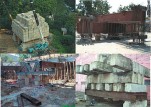Specifics of Construction of Tall Buildings Foundations

The construction of modern high-rise buildings is almost unimaginable without setting deep foundations, which is caused by the fact that majority of such buildings have a huge underground part and it is necessary to transmit very high loads onto reliable grounds that are at a relatively large depth. The design and installation of such foundations is a complex geotechnical matter that is solved at the stage of simulation, onsite testing and operation when the foundation has a design load. This article deals with the peculiarities of the construction of such foundations, the assessment of their interaction with the base and the challenges that arise in the process.
Piles and barrettes as elements of deep foundations
The main load-bearing elements of the foundation - piles or barrettes – that are installed directly on the construction site may in some cases be up to 60 meters long. In this case, their lower end can be sunk in the rocky soil - robust low-compressible soil that has high deformation and strength characteristics (granite, limestone, dolomite, sandstone of various degrees of weathering and fracturing) – as well as compressible soil (solid clay, sand). In the first case, the bearing capacity of such compression-piles is very high; this makes it possible to effectively construct high-rise buildings and to expect them to receive relatively low settings (within a few centimeters).
However, with the load on one pile of several thousand tons its shaft will inevitably undergo compression, thus leading to the emergence of certain forces of friction on its side surface; this may in some way relieve the lower end of the element. Therefore, it is not quite correct to consider a pile or a barrette that is longer than 30 m to be a compression-pile in the classical sense as the entire load is transferred along the lower end of the element and there is no side friction because there is practically no vertical movement. In the second case the highly loaded foundation element undergoes large vertical movements, which causes partial or complete mobilization of friction forces on the side surface and resistant forces at the bottom end.
This model corresponds to the classical “shaft bearing” pile. Their length pretty large and their side surface welldeveloped (a large diameter of the pile or large sides of the barrette), these elements are also able to carry heavy loads up to several thousand tons, but their bearing capacity will certainly be inferior to that of the piles that were buried into the rocky or other low compressible soil. A simple visual comparison of the cities with a large number of high-rise buildings (such as New York, Chicago) and those with a relatively low number (e.g.: Moscow, St. Petersburg) allows us to see the effectiveness of deep foundations that are buried in the rocky soil (here it does not lie relatively far from the surface). In the case of many Russian cities it is often impossible to choose such a “simple” way of building foundations and it is necessary to use deep foundation elements like “shaft-bearing” ones.
Full content of this issue you can read here
The full version of the article can be read in our printed issue, also you can subscribe to the web-version of the magazine
 Written by: Vitaliy Sidorov, doctor of science, assistant professor and Armen Ter-Martirosyan, doctor of science, associate professor, Federal State Budgetary Educational Institution of Higher Professional Education Moscow State University Of Civil Engineering, “Geotechnika” research and education center at MSUCE
Written by: Vitaliy Sidorov, doctor of science, assistant professor and Armen Ter-Martirosyan, doctor of science, associate professor, Federal State Budgetary Educational Institution of Higher Professional Education Moscow State University Of Civil Engineering, “Geotechnika” research and education center at MSUCE


